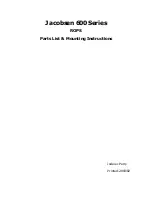
UTD2000M
User
Manual
Operational
Steps
are
the
followings;
1.
Set
the
probe
and
the
attenuation
coefficient
of
CH1
channel
the
same
way
as
in
the
former
case.
2.
Set
trigger
settings.
①
.Press
MENU
key
located
in
the
trigger
control
area
to
display
trigger
setting
menu.
②
.
While
under
this
menu,
use
menu
operation
key,
“F1
to
F5”,
respectively
to
set
the
trigger
type
as
edge,
signal
source
as
CH1,
trigger
coupling
as
DC,
trigger
mode
as
single
time
and
slope
type
as
rising.
③
.
Adjust
horizontal
time
base
and
vertical
scale
to
a
proper
scope.
④
.
Turn
“LEVEL”
knob
to
adjust
an
appropriate
trigger
level.
⑤
.
Press
RUN/STOP
key
to
start
the
oscilloscope
and
let
it
wait
the
appearance
of
a
signal
that
satisfies
the
trigger
condition,
in
case
there
is
a
signal
that
satisfies
the
set
trigger
level,
the
unit
shall
take
a
sample
for
once
and
have
it
displayed
on
the
screen.
With
this
function,
occasional
events
can
be
easily
captured,
i.e.
sudden
burr
with
relatively
large
amplitude:
the
trigger
level
is
set
to
be
a
bit
higher
than
normal
signal
level.
Press
RUN/STOP
key
to
standby
and
when
the
burr
appears,
the
unit
will
trigger
automatically
and
record
waveform
for
a
period
before
and
after
the
trigger.
In
order
to
observe
the
waveform
before
the
occurrence
of
burrs
easily,
negative
delayed
trigger
in
different
length
can
be
obtained
by
changing
the
horizontal
position
of
the
trigger
position
through
turning
the
horizontal
“POSITION”
knob
located
on
the
horizontal
control
area
of
the
panel.
Fig.
3
‐
2
Capture
a
Single
Time
Signal
3.3
Reduce
Random
Noise
in
a
Signal
If
the
signal
under
test
contains
random
noise,
users
can
filter
or
reduce
the
noise
by
adjusting
the
settings
of
this
oscilloscope
in
order
to
avoid
its
interference
on
subject
signal
during
the
measurement
(waveform
is
shown
in
below
picture).
64
















































